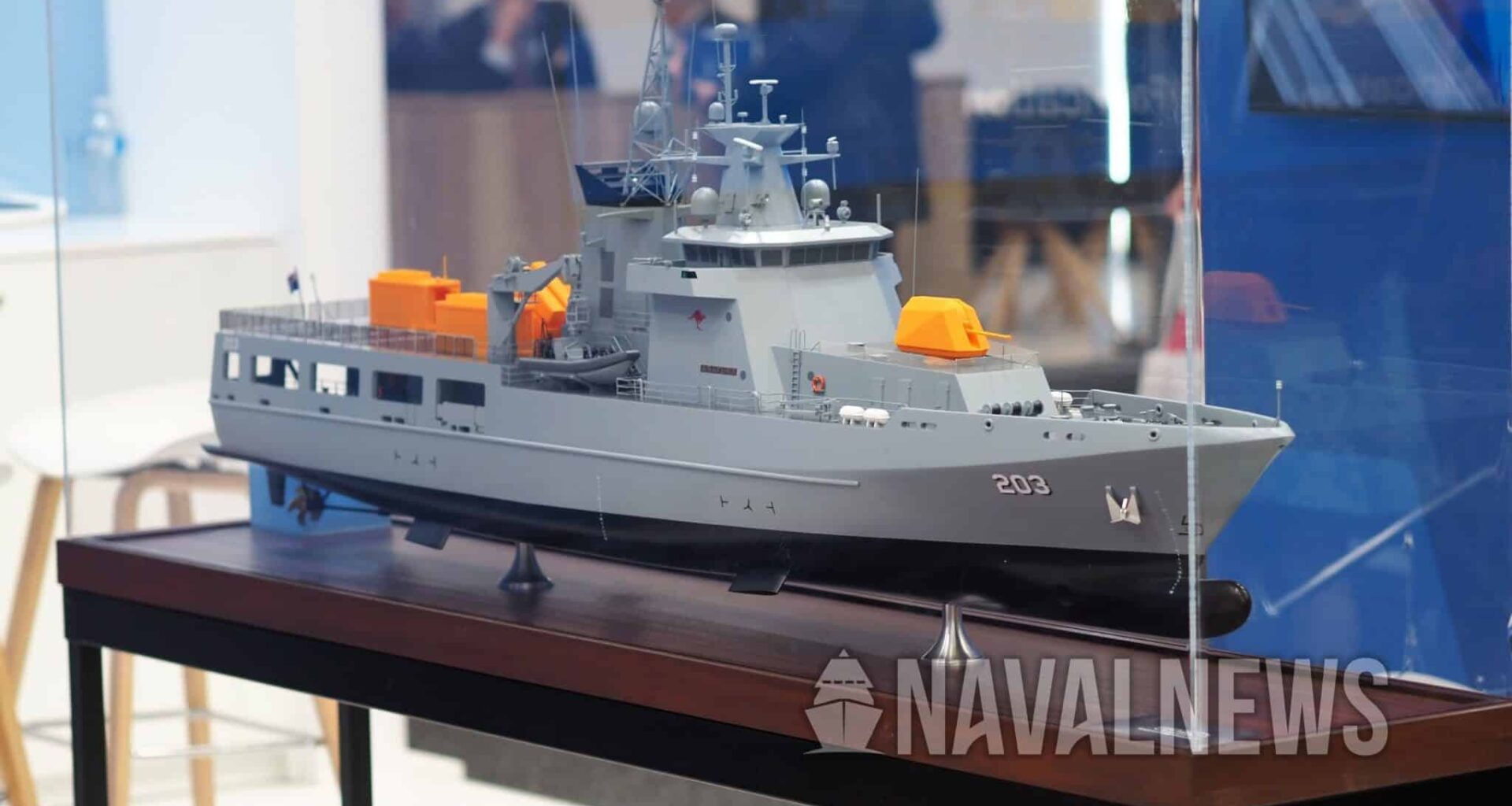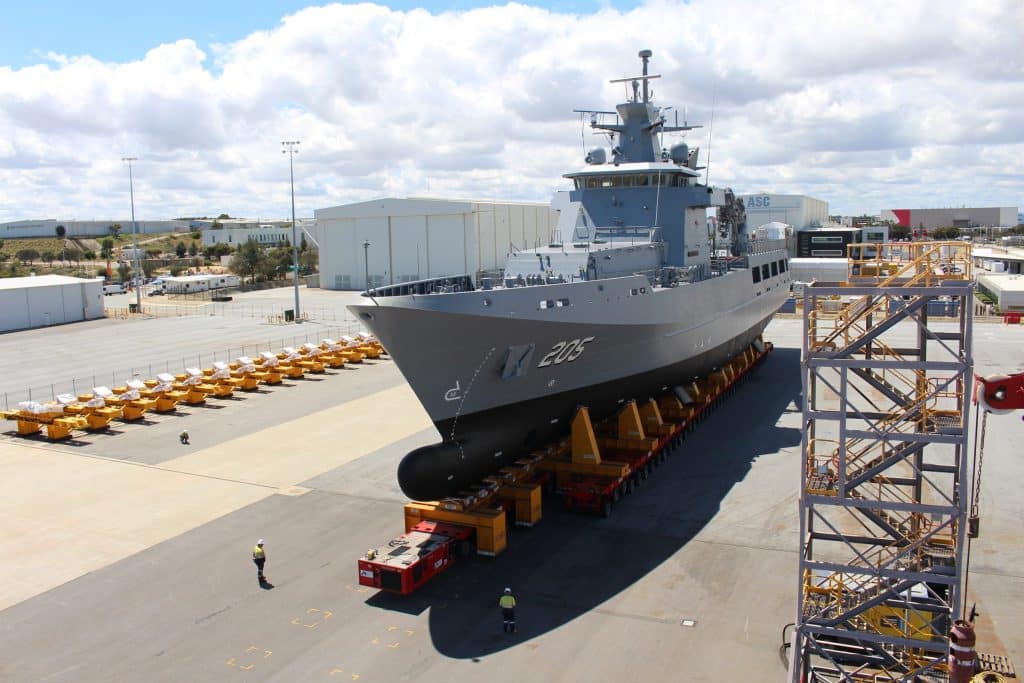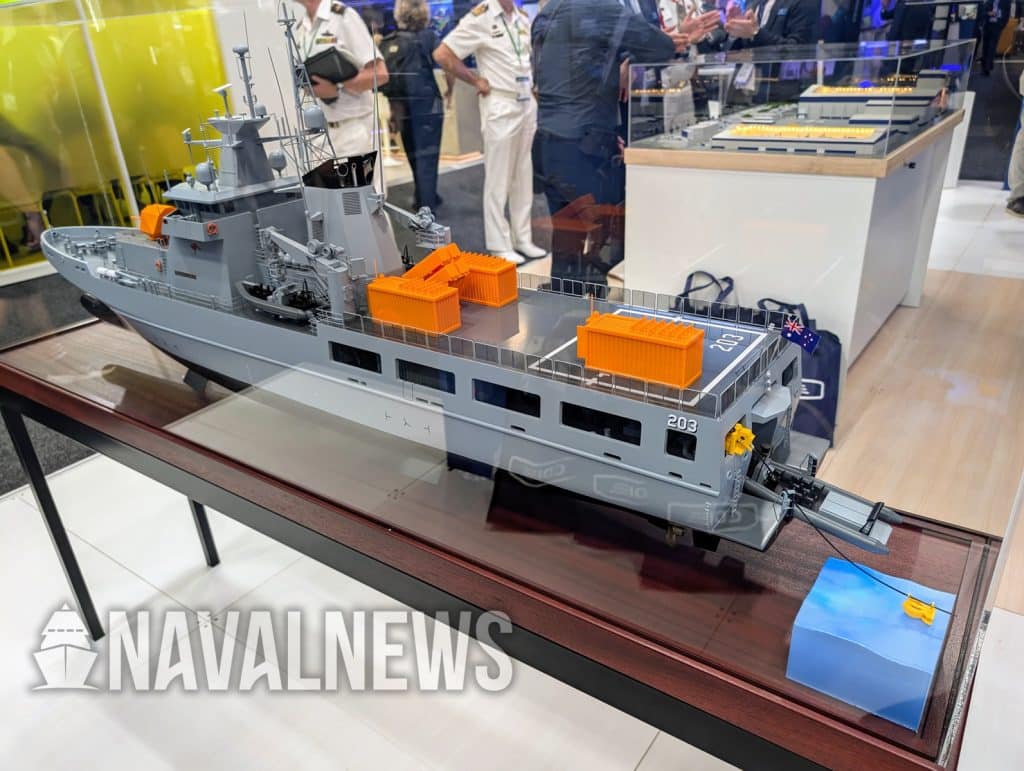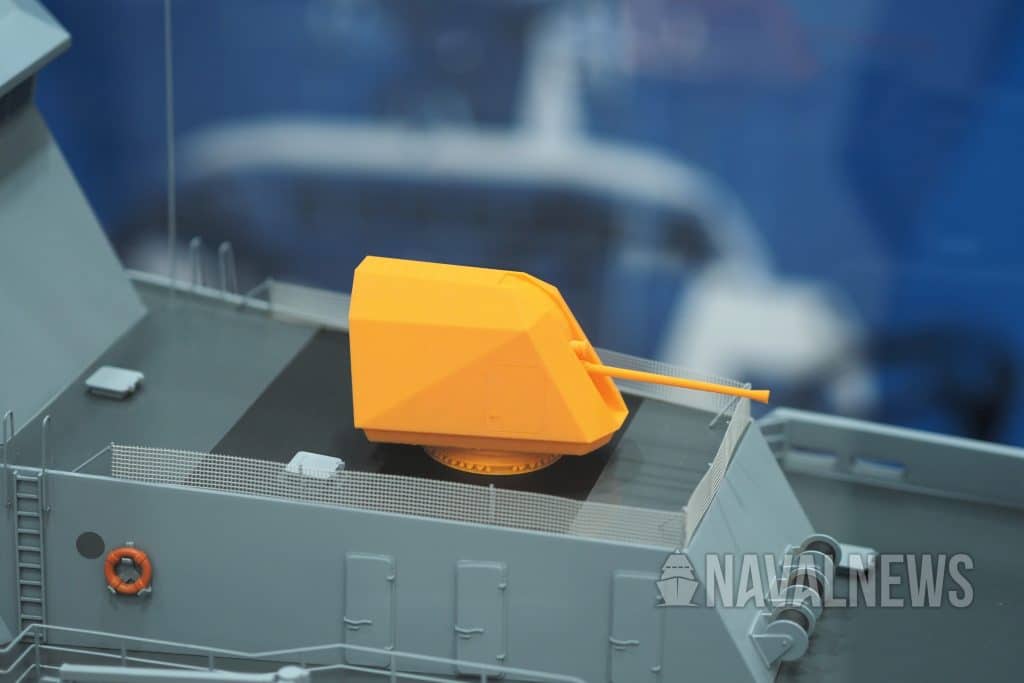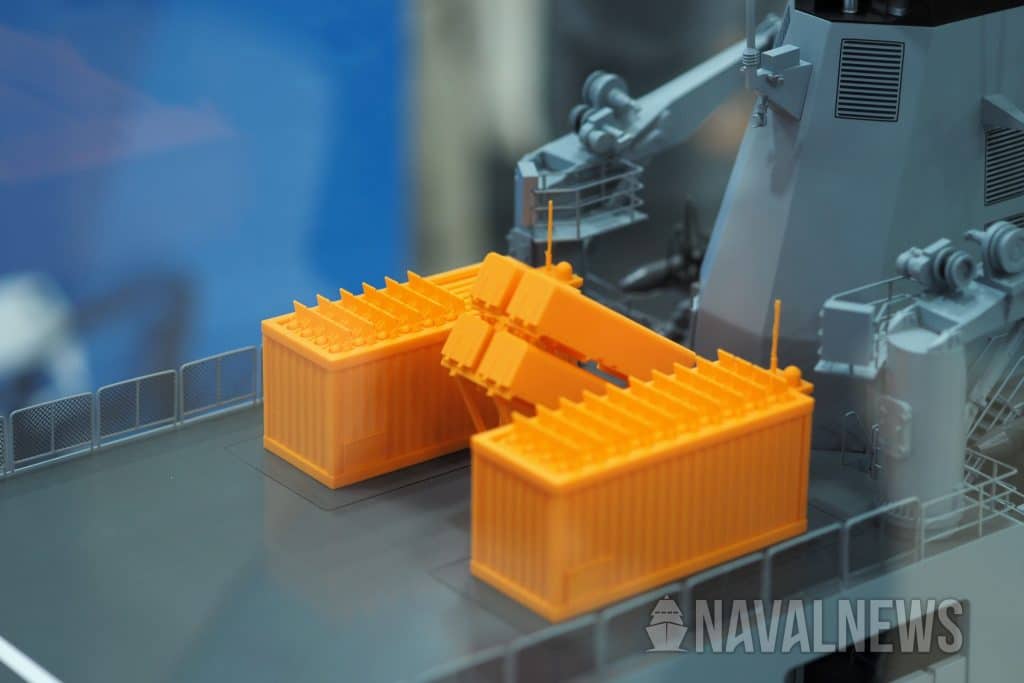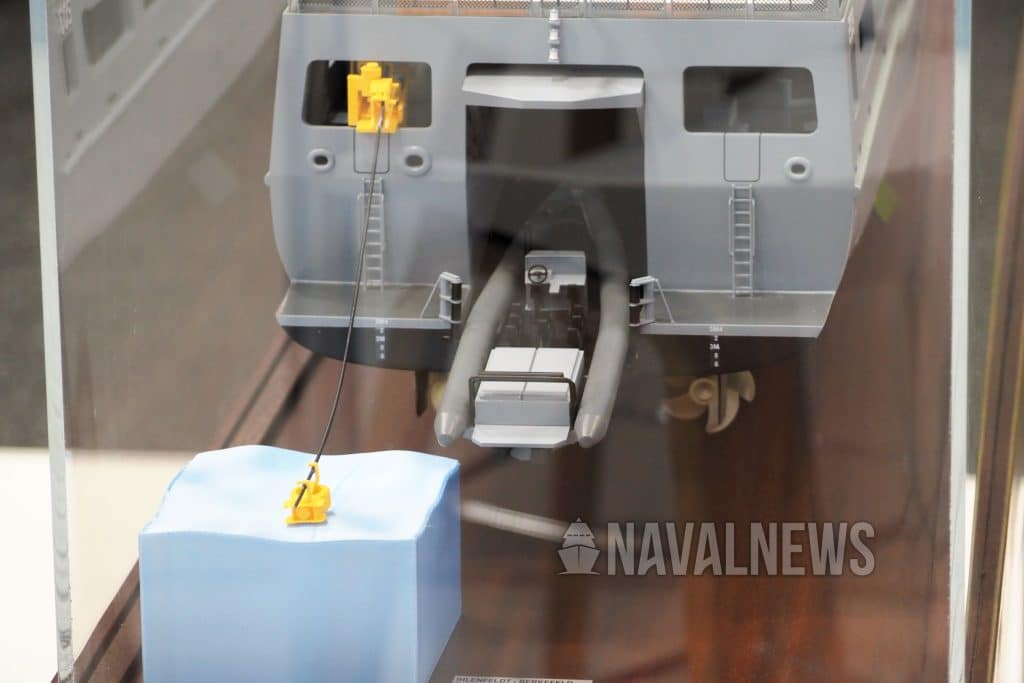Henderson, WA-based shipbuilder Civmec has revealed a number of upgrades for RAN Arafura-class OPVs termed “Capability Enhancement”. The builder presented the proposal as part of their presentation at the Indo Pacific 2025 International Maritime Exposition in Sydney this week.
In discussion with Naval News Civmec emphasises the modular military off the shelf-character of the individual upgrades. The yard also notes how such enhancements would not change previously planned construction timelines, but rather see notional integration as part of a capability insertion effort later on.
The Arafura-class includes a total of six 1,600 ton-offshore patrol vessels, originally procured for the Royal Australian Navy under the SEA 1180 program since 2017. The project initially intended to build 12 vessels to a modified design based on Luerssen’s PV-80 OPV, also in service with the Royal Brunei Navy as Darussalam-class. The modified Australian design included a new 40 mm-gun, which the program later abandoned over integration problems.
NUSHIP Pilbara before the recent launch at Civmec in Henderson, WA. Image Civmec.
Arafura adding numbers to fleet despite historical problems
The Australian government under Anthony Albanese in 2024 then decided to cancel procurement of six vessels, reducing SEA 1180 to the first batch of six OPV. Instead, the Albanese government seeks to procure more capable general purpose frigates, under the SEA 3000 program, downselecting the Japanese “Upgraded Mogami”-class frigate in August this year.
South Australia-based ASC Shipbuilding (now BAE Systems Maritime Australia) meanwhile proceeded to complete two of the vessels, HMAS Arafura, and yet to be commissioned NUSHIP Eyre, delivering them to RAN earlier this year. Civmec then assumed production of the remaining four ships, and has so far launched one hull, NUSHIP Pilbara, as previously covered by Naval News.
Civmec emphasises rapid integration of already available capability in consideration of the available space and weight reserve on Arafura.
Integration issues as outlined above have resulted in the new OPVs only being lightly armed, with a 25 mm Bushmaster autocannon in a Typhoon weapons mount. Arafura carried over this armament from retired Armidale-class patrol boats. The Typhoon mount combined with machine guns results in a basic design only capable of low-intensity patrol and presence operations. Meanwhile the Australian Navy faces an acute need for rapid fleet growth and enhanced anti-surface and anti-submarine warfare capabilities.
Civmec proposes the Arafura Capability Enhancement with these considerations in mind. The Capability Enhancement includes integration of a large calibre main gun, container-launched loitering munitions or optionally reconnaissance drones, and an ASW-capability via a towed variable depth sonar.
The Bofors 57 mm Mk 3 autocannon is the standard gun on the Luerssen PV-80 design.
Missiles and drones as notable armament upgrades
The main gun-upgrade would be the Bofors 57 mm Mk 3 autocannon. The gun is already part of the basic PV-80 design, from which Australia adapted the Arafura-class. Courtesy of programmable ammunition the gun offers significant flexibility in engaging surface-, air- and land-targets. The Bofors Mk 3 is in use with a number of foreign navies, beyond Brunei also on German coast guard OPV and the navies of Sweden, Finland and Canada, among others.
The remaining modifications are located at the stern of the OPV. On the large flight deck the Arafura-upgrade would install a quadruple launcher for NSM antiship missiles, facing astern. The Royal Australian Navy is presently introducing NSM as new standard antiship missile across the fleet. In addition, multiple ISO containers would carry a large number of loitering munitions, or alternatively reconnaissance drones for ISR. The container design is a recent evolution of a configuration which SH Defense developed in cooperation with UVision.
The antiship missile launcher would use NSM, already in service with RAN. SH Defense-designed container-based drone launchers would store dozens of loitering munitions or similar-sized drone payloads.
Finally, the Capability Enhancement-effort would see the integration of the Thales CAPTAS 1-variable depth sonar below the flight deck. The upgrade would locate this module either port or starboard of the RHIB launch bay at the stern. CAPTAS-1 is a relatively compact design which offers a modular and cost effective ASW-capability. The Thales VDS allows standalone or networked multistatic operations, including interoperability with hull mounted sonar systems and sono buoys.
No replacement, but complement to frigates and destroyers
Other enhancements beyond these measures remain more notional. One requirement would likely be a more capable sensor-suite in order to enable targeting for the proposed weapons enhancements. Civmec emphasises that the focus of the Arafura Capability Enhancement is on rapid integration of available equipment. The builder does not propose to turn the OPV into a “Tier 1” or “Tier 2”-combatant, referring to terms used by the Australian government for destroyers and frigates.
The Thales CAPTAS-1 VDS would provide a basic ASW-capability to Arafura.
As a result, the Capability Enhancement as presented would provide the Royal Australian Navy with a relatively rapid upgrade. The move would allow a more flexible deployment of the six Arafura-class OPV. Such a step could also reduce operational pressure on higher value platforms, such as Hobart, Hunter or Upgraded Mogami. However, whether RAN and the Australian Department of Defence will show interest in this proposal remains to be seen.

